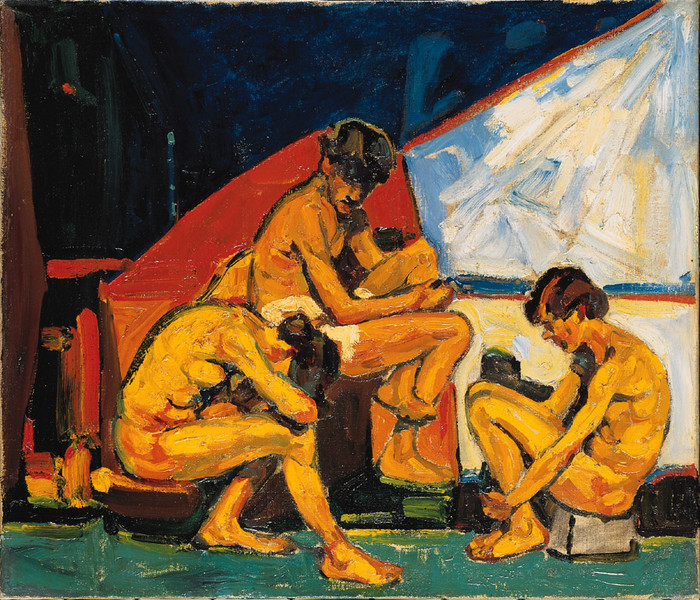Adolf Hölzel

Adolf Hölzel
Three Nudes, 1908/09
Oil on canvas
53,3 x 62,3 cm
Acquired/Erworben 1984
Adolf Hölzel was a pioneer of abstract art in Germany since he worked as professor at the Stuttgart academy from 1906 to 1919. His later prominent pupils developed his theories of color, line and form further as a basis of abstract 20th century art. When looking at Hölzels early paintings with religious motifs it is hard to understand at first how there could be a path from here to the stereometrically reduced quality of the figures in pictures by Schlemmer via Baumeister’s surreal color forms to the mathematical pictures of an artist like Camille Graeser. But it is the case: the key is to be found in Hölzel’s austerely rational figure compositions and the crystalline surface structure of his pictorial backgrounds on the one hand, and then in the systematic of his theory and lectures, based on color theories and formal developments. In Three Nudes Hölzel arranged the bodies as if they were an imaginary triangle in pyramid form. The painterly structured ‘triangular areas’ in the background are already anticipating the later purely abstract works.
Adolf Hölzel, der von 1906 bis 1919 an der Stuttgarter Akademie unterrichtete, war ein Pionier der ungegenständlichen Kunst. Seine später prominenten Schüler entwickelten seine auf Linie, Form und Farbe basierende Lehre zur Grundlage der abstrakten Kunst in Deutschland weiter. Vor seinen religiösen Gemälden wird man zunächst kaum nachvollziehen können, wie es von hier aus einen Weg geben konnte zur stereometrischen Figürlichkeit eines Schlemmer, zu den surrealen Farbformen Baumeisters oder den ›konkreten‹ Bildern eines Graeser. Der Schlüssel liegt in Hölzels streng rationalen Figurenkompositionen und in der kristallinen Flächenstruktur seiner Bildhintergründe einerseits, in der Systematik seiner auf Farbtheorien und Formentwicklungen fußenden Lehre andererseits. In Drei Akte hat Hölzel die Körper zu einem imaginären Dreieck in Pyramidalform geordnet, während die ›Dreiecksflächen‹ des Hintergrunds einen abstrakt-malerischen Raum schaffen.
Three Nudes, 1908/09
Oil on canvas
53,3 x 62,3 cm
Acquired/Erworben 1984
Adolf Hölzel was a pioneer of abstract art in Germany since he worked as professor at the Stuttgart academy from 1906 to 1919. His later prominent pupils developed his theories of color, line and form further as a basis of abstract 20th century art. When looking at Hölzels early paintings with religious motifs it is hard to understand at first how there could be a path from here to the stereometrically reduced quality of the figures in pictures by Schlemmer via Baumeister’s surreal color forms to the mathematical pictures of an artist like Camille Graeser. But it is the case: the key is to be found in Hölzel’s austerely rational figure compositions and the crystalline surface structure of his pictorial backgrounds on the one hand, and then in the systematic of his theory and lectures, based on color theories and formal developments. In Three Nudes Hölzel arranged the bodies as if they were an imaginary triangle in pyramid form. The painterly structured ‘triangular areas’ in the background are already anticipating the later purely abstract works.
Adolf Hölzel, der von 1906 bis 1919 an der Stuttgarter Akademie unterrichtete, war ein Pionier der ungegenständlichen Kunst. Seine später prominenten Schüler entwickelten seine auf Linie, Form und Farbe basierende Lehre zur Grundlage der abstrakten Kunst in Deutschland weiter. Vor seinen religiösen Gemälden wird man zunächst kaum nachvollziehen können, wie es von hier aus einen Weg geben konnte zur stereometrischen Figürlichkeit eines Schlemmer, zu den surrealen Farbformen Baumeisters oder den ›konkreten‹ Bildern eines Graeser. Der Schlüssel liegt in Hölzels streng rationalen Figurenkompositionen und in der kristallinen Flächenstruktur seiner Bildhintergründe einerseits, in der Systematik seiner auf Farbtheorien und Formentwicklungen fußenden Lehre andererseits. In Drei Akte hat Hölzel die Körper zu einem imaginären Dreieck in Pyramidalform geordnet, während die ›Dreiecksflächen‹ des Hintergrunds einen abstrakt-malerischen Raum schaffen.
Tag: Adolf Hölzel
